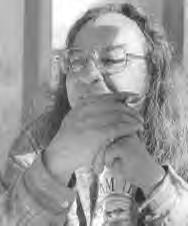|
|
Canku Ota |
|
|
(Many Paths) |
||
|
An Online Newsletter Celebrating Native America |
||
|
October 20, 2001 - Issue 47 |
||
|
|
||
|
Mahnoomin-Wild Rice |
||
|
by Jim Northrup shared with permission from Fond du Lac Follies |
 I will never
forget September 11th. I had one of the best days ricing I have ever had in almost 40 years of ricing. My godson
Zac and I went to East Lake to harvest wild rice. We were invited by the people of East Lake to come and share
the gift from the Creator. Once again the people were displaying the Anishinaabe trait of generosity. I will never
forget September 11th. I had one of the best days ricing I have ever had in almost 40 years of ricing. My godson
Zac and I went to East Lake to harvest wild rice. We were invited by the people of East Lake to come and share
the gift from the Creator. Once again the people were displaying the Anishinaabe trait of generosity. I lost my canoe at the beginning of the season and I was on my way to Superior to replace it with a new one. As I came by former legislator Willard Munger's motel I noticed there were a couple of aluminum canoes in the yard. I stopped and asked Willard's son if he wanted to sell one of them. He said no but was willing to rent one for a couple of weeks. So, I had a canoe for ricing. It is nice the way things fall in place. My old pole has seen one too many seasons so Jim repaired it. He replaced the crutch end and the pole end. Early in the season we went ricing at Dead Fish Lake here on the Reservation. The rice beds looked good from the rice tower but once we got out on the lake we quickly realized the rice worms had started harvesting before we got there. My son Matthew and I took a look at the Moose Horn River but the rice wasn't ripe. There were a lot of worms there too. The Four Oaks drum group has been staying here since early July. They leave for the weekend to sing at powwows but return here to the World Headquarters of the Fond du Lac Follies to rest, rebuild and refurbish their vehicles. Tony Sayers, Bill Sayers, David Manual and Zac are the singers. While they were here they tanned a hide, worked on my sister's house and made themselves useful. Some of them went ricing and they learned how to make wild rice without machines. They took their drum to the community center and sang powwow songs. My son Jim made a dancing pit, and they are taking turns dancing on the rice. While one dances, another one sings with a hand drum; it makes the dancing easier. Zac made a fanning basket to use on the rice. This was his first time making rice like this. |
|
|
| The bright red of the maple, brighter red of the sumac and yellow of the birch trees remind
me of why I am glad to live in northern Minnesota. The Norway pines have some brown needles and I expect to see
the orange of the tamarack trees soon. After looking at different shades of green all summer it is a visual feast in the woods now. I like to go out to the Ditchbanks area of the Rez and listen to the quiet. When I am in the woods, I know my relatives walked the same ground, paddled the same lakes and felt the seasons change as I do. I feel connected. I like to bring Ezigaa to the woods with me. That 11-year-old grandson likes to look at stuff in the woods. Some blueberry bushes reminded him of all the berries he picked last summer and he told a story about berry picking. Together we watched a hawk that was hunting. We didn't have to say anything, just watched him flying about. It is peaceful in the woods. |
|
|
|
How To Cook Commercial Paddy-grown "Wild Rice"
|
|
Wild Rice |
|
|
||
|
|
||
| Canku Ota is a free Newsletter celebrating Native America, its traditions and accomplishments . We do not provide subscriber or visitor names to anyone. Some articles presented in Canku Ota may contain copyright material. We have received appropriate permissions for republishing any articles. Material appearing here is distributed without profit or monetary gain to those who have expressed an interest. This is in accordance with Title 17 U.S.C. section 107. | ||
|
Canku Ota is a copyright © 2000, 2001 of Vicki Lockard and Paul Barry. |
||
|
|
|
|
|
The "Canku Ota - A Newsletter Celebrating Native America" web site and its design is the |
||
|
Copyright © 1999, 2000, 2001 of Paul C. Barry. |
||
|
All Rights Reserved. |
||

